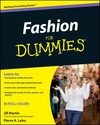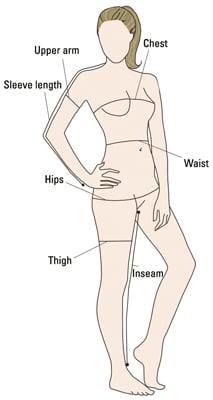How to measure..
How to Get Your Body Measurements
Most women have a good idea what their measurements are, but rather than assume you know, get an accurate measurement. Going to a tailor will give you more accurate measurements, but you can certainly get a close approximation handling the measuring tape yourself. The measurements that you definitely need are your chest, waist, hips, and inseam. You may also want to take your thigh and upper arm measurements. The process for getting your body measurements is simple. For example, knowing how to measure waist and hips is common knowledge, but some women do not know exactly where to start / stop the measurement for a more accurate result.
When taking these measurements, use a cloth tape measure, not a metal one. Make sure that, when you circle your chest, waist, or hips, the tape is level and neither too tight nor too loose. Also measure yourself on your bare skin, not over clothes. And this may sound silly, but don’t trust your memory — be sure to write the measurements down!
How to measure waist, hips, chest, and more
The diagram above depicts the most appropriate locations to begin and end measurement for the different areas of your body. Often times, women will measure at the wrong location and get false results. For example, when measuring your waist, some people take the measurement below the belly button when your natural waistline is located above the belly button! Check out the easy-to-follow instructions for getting accurate measurements for each body part below:
-
Chest: Measure the circumference of your chest. Place one end of the tape measure at the fullest part of your bust, wrap it around (under your armpits, around your shoulder blades, and back to the front) to get the measurement.
-
Waist: Measure the circumference of your waist. Use the tape to circle your waist (sort of like a belt would) at your natural waistline, which is located above your belly button and below your rib cage. (If you bend to the side, the crease that forms is your natural waistline.) Don’t suck in your stomach, or you’ll get a false measurement. If you generally wear your clothes below your waist, take that measurement as well.
-
Hips: Measure the circumference of your hips. Start at one hip and wrap the tape measure around your rear, around the other hip, and back to where you started. Make sure the tape is over the largest part of your buttocks. Because making sure the tape is level back there can be hard, try to do it in front of a mirror.
-
Inseam: This is the distance from the uppermost inner part of your thigh to the bottom of your ankle. You can measure your inseam in two ways.
-
With help: While you’re wearing a pair of pants, have a friend stretch the tape from your crotch to the bottom of your ankle.
-
Without help: If you have a pair of pants that fit you perfectly (and they shouldn’t be too loose around the waist), measure the inseam of the pants, again from the crotch to the hem.
The proper inseam on a pair of pants you’re going to purchase will depend on the height of the heel you’ll be wearing with them.
-
-
Thigh: Measure the circumference of the fullest part of your thigh. Wrap the tape measure around your thigh from front to back and then around to the front. You may be tempted to cheat by lowering the tape measure a few inches, but then you won’t get an accurate measurement.
-
Upper arm: Measure the circumference of your arm. Wrap the tape measure around the widest part of your upper arm from front to back and around to the start point.
-
Sleeve length: Get help for this one because it’s hard to do yourself. Place your hand at your waist (your elbow should be bent at a 90-degree angle). Then start at the middle of the back of your neck and measure to your shoulder, down your arm to the elbow, and then on to the wrist.
You may need a family member or friend to assist you with the measurements. If you have a garment that fits perfectly, measuring the garment rather than your body can be a good substitute.




Leave a comment